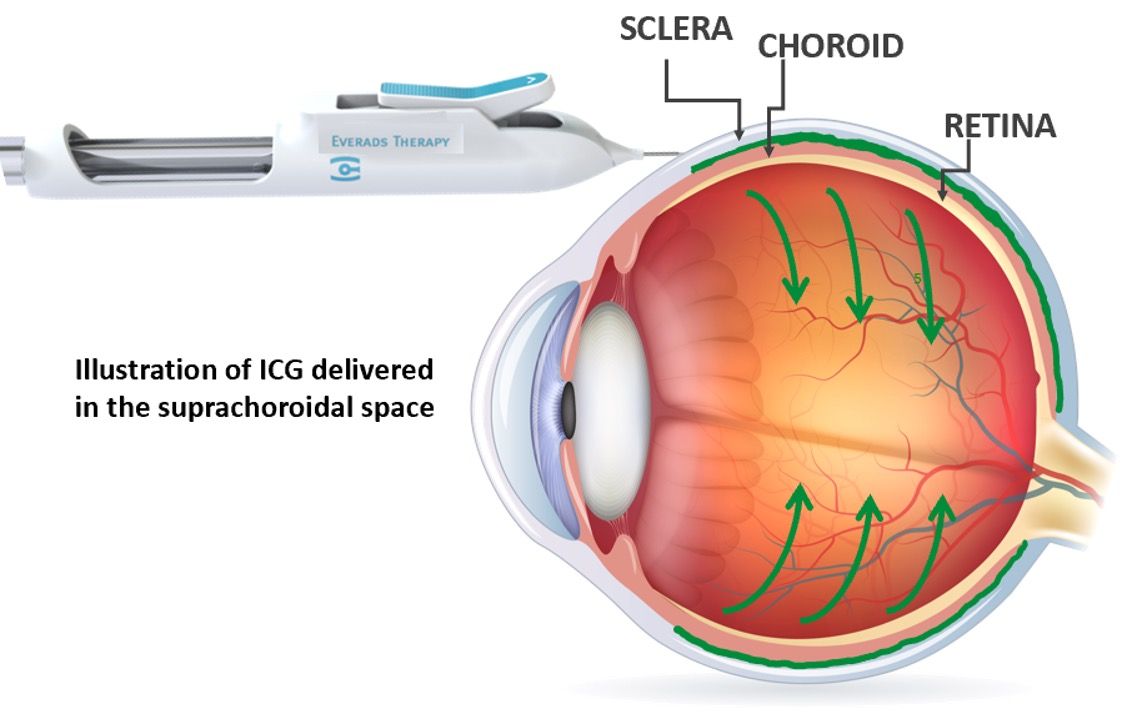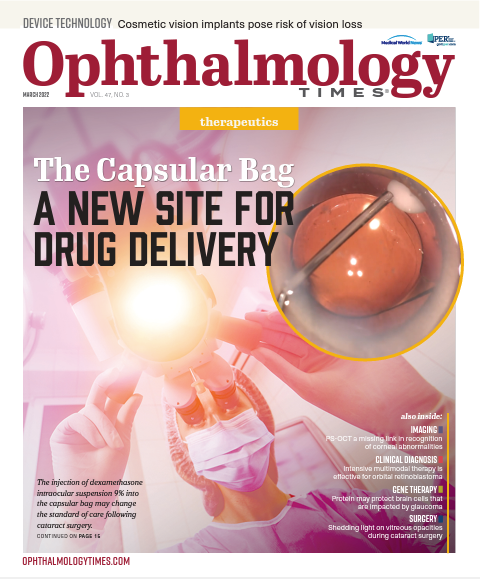Publication
Article
Digital Edition
Suprachoroidal delivery system gets drug to the macula, posterior segment
Author(s):
Provides safe, effective injection to target choroidal, retinal tissues
Reviewed by Yoreh Barak, MD

A novel suprachoroidal delivery system being developed by Everads Therapy (Tel Aviv, Israel) was tested in nonhuman primates and demonstrated its ability to deliver large drug volumes rapidly and safely to the back of the eye. The study was conducted using indocyanine green (ICG) dye to enable visualization of the distribution achieved with the device.
Drug delivery using this technology is performed by inserting the tip of the device’s needle tangentially into the sclera up to a depth controlled by a sleeve stopper on the needle. A blunt tissue separator is then extended and retracted to open a path from the sclera into the suprachoroidal space. This is followed by injection of drug, or in the case of this study the ICG. The device is designed to be used with a standard Luer lock syringe.
Yoreh Barak, MD, head of Retina at Rambam Medical Center, was the lead investigator of a study that used 6 live and 6 cadaver eyes of nonhuman primates into which investigators injected 150 μl or 200 μl of ICG. They evaluated the dye’s distribution throughout the posterior pole, as well as the tolerability of the procedure.
“Everads’ suprachoroidal delivery system has the potential to provide safe and effective delivery of therapy to target choroidal and retinal tissues via the suprachoroidal space and is differentiated by its ability to deliver high volumes and large particles rapidly to the macula and throughout the posterior pole,” Barak explained
Barak and colleagues examined the eyes by biomicroscopy and fundus and optical coherence tomography (OCT) imaging before the procedure and immediately after, then at 1, 3, and 24 hours after the procedure.
ICG distribution
The investigators found that the ICG was distributed throughout the posterior segment in both the live and cadaver eyes. They observed rapid distribution in the macular region, and distribution throughout the posterior pole was seen within 24 hours in all in vivo eyes.
No adverse effects of the procedure developed during the 24-hour period of observation. The investigators reported that “anterior segment, color, and monochrome fundus images revealed no suprachoroidal blebs, retinal detachments, or hemorrhages associated with the dosing using the suprachoroidal delivery system. No ICG was seen in the vitreous or under the retina and no inflammatory reaction occurred after dosing as seen on slit-lamp evaluation.”
The retinal thickness did not change significantly on the OCT images. A mild increase in IOP occurred that was nonsignificant and resolved within 1 hour of injection. Based on these findings, investigators concluded that the injection was successful and well tolerated. The dye was distributed throughout the posterior pole after the injection and continued during the period of observation to the macula and the optic nerve.
“Opening a tangential path with the blunt tissue separator enabled safe and extensive distribution of large volumes throughout the posterior segment,” they said. “The device may provide safe and effective delivery of treatments to the macular region and posterior pole.”
“This unique delivery technology, which has the potential to rapidly and safely deliver treatment to the macula and posterior pole via the suprachoroidal space, is currently being evaluated by a number of pharmaceutical companies for delivery of various treatments, including gene therapy,” according to Moshe Weinstein, CEO of Everads Therapy Ltd.
Yoreh Barak, MD
E: Yoreh_b@rmc.gov.il
This article is adapted from the poster presentation at the 2021 American Academy of Ophthalmology annual meeting held recently. Yoreh Barak is a consultant to Everads Therapy Ltd.
Moshe Weinstein





